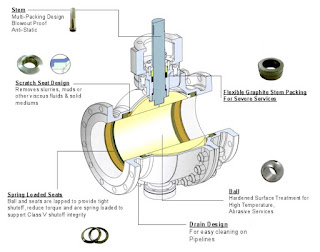 |
| Cutaway view of a metal seated ball valve Courtesy SVF Flow Controls |
Reviewing some of the attributes of ball valves that might make them the best choice:
- Tight closure.
- Very low resistance to flow.
- Best suited for applications requiring fully closed or open control.
- 90 degrees of rotational motion from open to closed position yields rapid response.
- Comparatively compact, without the space requirement for extending stem movement as required by some other valve types.
- Wide range of construction materials for the body, stem, ball, and seals.
- Moderate force required for actuation.
- A full size port provides for very low pressure drop across the valve when fully open.
- Requirements for maintenance are generally low.
- No lubrication required.
One limiting factor for the application of ball valves, as with many other valve types, is the seat material. Most often, seats are fabricated from elastomeric or other "soft" materials. While these materials provide good sealing performance, their inability to withstand higher fluid temperatures makes them unsuitable for some industrial applications. To satisfy a wider range of process applications, some manufacturers offer metal seated ball valves. The metal seated valves are designed to meet severe service applications involving high temperature, erosive fluids and other challenging shutoff requirements where soft seats would rapidly deteriorate.
One manufacturer, SVF Flow Controls, provides metal seated ball valves in sizes 1/2" through 12" with a full port design. Because of their intent for severe service applications, metal seated ball valves are generally provided with other design features that enable their application across a wide range of high temperature or erosive fluid applications.
I have included a data sheet below that provides additional technical information, or you may contact a valve application specialist for any assistance you need. Share you fluid control challenges and get effective solutions.